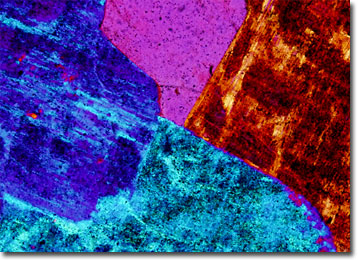Polarized Light Microscopy Digital Image Gallery
Arfvedsonite Granite
Granite is a type of rock primarily composed of quartz and feldspars that is generally believed to be formed when magma solidifies under pressure. It is the most common igneous rock found in the crust of the Earth.

View a second image of Arfvedsonite Granite
Formed at various periods in geologic history, some granites are among the oldest rocks known on the planet. Since they are formed deep inside the Earth, exposures of granite only develop when overlying rocks erode or the crust of the planet shifts. Granite has been mined for use as a paving and building stone since antiquity, and several deposits have been found that contain commercially important gemstones and minerals. The exact mineralogical composition of granites is relatively variable, but the rocks are usually classified based upon the relative abundance of plagioclase and alkali feldspar.
In alkali granites, arfvedsonite is a common constituent, as are other sodic-amphiboles and pyroxenes. The mineral, which was first discovered in Greenland and is named for Swedish chemist Johan Arfvedson, is an iron-rich sodium silicate. It is dark green or black in color and has a relative hardness of 6. Deposits of alkali granite can be found in various locales, such as New England and Norway, but are most extensive in Nigeria.
